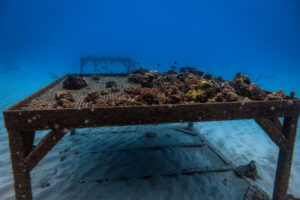COP16 - Upgrades agreed to marine protection decision processes
World leaders have adopted a plenary decision to update the process through which biologically and ecologically significant areas are selected for protection across the marine space, including within the High Seas.
After eight years of complicated negotiations, governments made a breakthrough decision within the final few days of this year’s now closed UN Convention on Biological Diversity, COP16, to update methods by which decision-makers select marine spaces to protect in the fight to halt and reverse biodiversity loss.
The process for identifying Ecologically or Biologically Significant Areas (EBSAs) of marine space is one that has been pinpointed as “crucially important” for the protection of the ocean within the implementation of the biodiversity framework. These areas are recognised for their special importance in terms of biological and ecological characteristics by providing essential habitats, food sources, or breeding grounds for species.
With the plenary adoption of the decision at COP16 last week, this now updates the process for how leaders and decision-makers can “scientifically identify” these areas within the ocean space both within and beyond national jurisdiction. Of vital significance is that this now includes the High Seas, complimenting the current Agreement under the United Nations Convention on the Law of the Sea on the Conservation and Sustainable Use of Marine Biological Diversity of Areas beyond National Jurisdiction (BBNJ).
“This may all sound technical, but it’s vital for implementing the Global Biodiversity Framework for the ocean,” said Andreas Hansen, director of Global Ocean Policy at The Nature Conservancy, a group that has been instrumental in bringing the conversation to this round of international negotiations.
“There will now be an updated database that can help decision-makers decide where to deploy protected areas and sustainable use measures in order to halt and reverse biodiversity loss. As the database will include information about biodiverse areas in national and international waters, there is also clear synergies with the BBNJ (High Seas) Treaty and efforts to establish Marine Protected Areas in the High Seas – a critical step to achieve the 30×30 targets for marine areas.”
The High Seas make up two-thirds of the world’s ocean meaning protection for the swathes of water that does not fall within the jurisdictional boundaries of individual countries is vital for hitting the 2030 targets to protect and restore 30% of the world’s habitats on land and in water.
Until the BBNJ agreement, however, there was no real legal mechanism for creating Marine Protected Areas within the High Seas.
“With this latest decision, we have now got an even clearer pathway to creating the protected areas on the High Seas that will be so critical to hitting the 30×30 targets,” said Nichola Clark, senior officer at Ocean Governance at the Pew Charitable Trusts.
“The EBSA process is a really important process to describe really important oceanic areas for science, ecology, and for providing crucial ecosystems. But the Convention on Biological Diversity is really clear there is no management to them, they are purely a scientific exercise to identify areas of importance,” Clark added.

The adoption of the update to the EBSA database has been described as one of the “bright spots” of COP16, which came to a close this weekend, bringing to an end two-weeks of negotiations between nation leaders.
Despite the flurry of good news and positive developments to have emerged over the course of this year’s summit, however, some have likened the overall indecision on crucial subjects such as ‘finance for nature’ as the “gut punch” that has “blurred” the positive steps to have emerged so far.
Held in Cali in Colombia, this year’s Conference has been a source of optimism and positivity towards the global target to protect and restore 30% of natural habitat on land and in water by 2030. It was anticipated that talks would therefore conclude in much the same manner when countries entered the final negotiations last Friday.
As the night trundled into the early hours of Saturday morning, it was varying states of confusion that delegates began to leave the closing negotiation early to catch their flights home without any firm decisions made on key topics, including the nature financing issue.
Countries are now being called upon “with great urgency” to continue these talks at an interim meeting in Bangkok next year.
Jennifer Morris, CEO of The Nature Conservancy, described the final indecision as a “blur” on the “bright spots” to have emerged from discussions over the last two weeks.
“As the talks went on into the morning, Parties had to depart, and COP16 was suspended without the adoption of a strategy to scale up finance for biodiversity,” she said in a post on social media over the weekend. “Simply put, we do not have an agreement on how to get funding to those who need it most or an operating budget. In the meantime, nature is in decline.”
Financial experts estimate that $200 billion in additional funding will need to be generated each year until 2030 to enable nations to reach their targets. Beyond this, it’s anticipated that $700 billion in additional finances will need to be generated to maintain work in halting and reversing the decline in global biodiversity and restoring natural habitats around the world.
Among the “bright spots” listed, seven countries and Quebec pledged an additional $163 million to the Global Biodiversity Fund, bringing its total to around $396 million.


"*" indicates required fields
Printed editions
Current issue
Back issues

Back Issues
Issue 43 Sir David Attenborough’s ‘Ocean’

Back Issues
Issue 41 Holdfast to the canopy
Enjoy so much more from Oceanographic Magazine by becoming a subscriber.
A range of subscription options are available.









